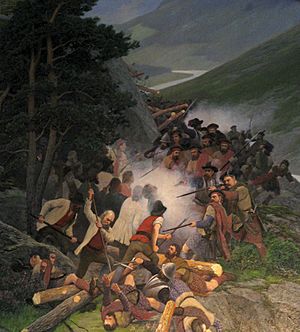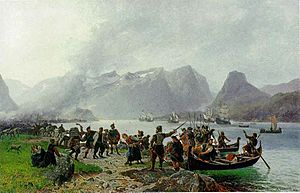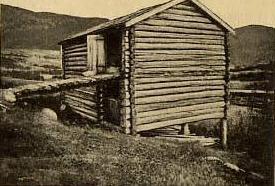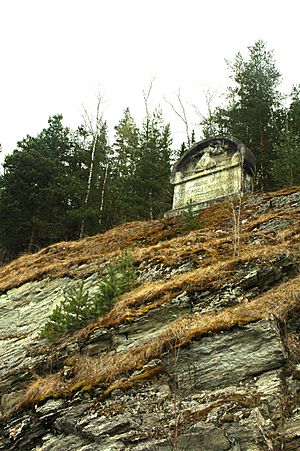Battle of Kringen facts for kids
Quick facts for kids Battle of Kringen |
|||||||
|---|---|---|---|---|---|---|---|
| Part of the Kalmar War | |||||||
 Detail of a painting of the battle by Georg Nielsen Strømdal |
|||||||
|
|||||||
| Belligerents | |||||||
| Scottish mercenaries | |||||||
| Commanders and leaders | |||||||
| Alexander Ramsay George Sinclair † George Hay Sir Henry Bruce |
|||||||
| Strength | |||||||
| 398 | 315 | ||||||
| Casualties and losses | |||||||
| 6 killed 12 wounded |
180 killed 134 captured |
||||||
The Battle of Kringen (Norwegian: Slaget ved Kringen) was a famous ambush in Norway. It happened when Norwegian farmers and villagers attacked Scottish mercenary soldiers. These Scottish soldiers were on their way to join the Swedish army during the Kalmar War. The battle is now a big part of Norwegian stories and legends, and it has given names to places in the Ottadalen valley.
Contents
Why the Battle Happened
Scottish Soldiers' Journey
In the early 1600s, there was a war called the Kalmar War between Denmark-Norway and Sweden. Some Scottish soldiers were hired to fight for Sweden. They were led by a man named Sir James Spens. The King of Scotland, James VI, actually supported Denmark-Norway, but these soldiers still went to help Sweden.
Two ships full of Scottish soldiers sailed from Scotland in August 1612. They met up in the Orkney Islands and then headed for Norway.
Blocked Sea Routes
The usual sea routes to Sweden were blocked by Danish-Norwegian ships. So, the Scottish soldiers decided to try a land route through Norway. Other Scottish and Dutch groups had used this route before. On August 20, their ships landed at Isfjorden in Romsdal. However, the area where they landed was very rough and difficult terrain.
The soldiers then began a long march. They walked up the Romsdalen valley and then down into the Gudbrandsdal valley.
Norwegian Farmers Prepare
The Norwegian people had heard that the Scottish soldiers were coming. They were already upset because of other events in the war, like a difficult march by another group of soldiers earlier that summer. Farmers and villagers from nearby areas like Vågå, Lesja, Lom, Dovre, Fron, and Ringebu decided to fight back.
A famous story says that the local sheriff, Lars Gunnarson Hågå, went into the church in Dovre. He struck his battle axe on the floor and shouted, "Let it be known - the enemy has come to our land!" This rallied the people to prepare for battle.
Who Fought
The Scottish forces had about 300 soldiers. Their main leaders were George Sinclair, Alexander Ramsay, George Hay, and Sir Henry Bruce. The Scottish soldiers were likely well-armed.
The Norwegian farmers and villagers had about 500 fighters. They used weapons like swords, spears, axes, scythes (farm tools), and some had muskets (old guns) and crossbows.
The Battle of Kringen
There are not many official records of the battle, but many stories have been passed down. Two Norwegians on horseback supposedly followed the Scottish troops. One was a woman named Guri, who is now known as Prillar-Guri (Guri the Blower). The other was an unnamed man. The man rode his horse facing backward to distract the Scottish soldiers.
The Ambush
When the Scottish soldiers reached the narrowest part of the Gudbrandsdal valley at a place called Kringen, Guri blew her horn. This was the signal for the ambush. The chosen spot was very steep, and the river ran close to the only road. This meant the Scots would be trapped between the river and the steep mountainside, which they couldn't climb.
According to the stories, the Norwegian fighters threw logs and rocks down the valley onto the Scottish soldiers. They also shot at them with crossbows and muskets. One of the first Scottish leaders to fall was George Sinclair. He was reportedly shot by a Norwegian fighter named Berdon Sejelstad. Sinclair was an important person in the Clan Sinclair in Scotland.
After the Fight
After the initial attack, close combat began. The Norwegian farmers fought with their swords, axes, scythes, and other tools they had. More than half of the Scottish soldiers were killed during the battle. Some managed to escape, but many were captured.
Almost all of the captured Scottish soldiers were executed later at Kvam. Only 14 survived and were sent to Christiania (as Oslo was then called) to be imprisoned. The soldiers who were killed were buried in a large grave at the local cemetery. This place was later called Skottehaugen (Scottish hill). Some of the Scottish officers, like Alexander Ramsay and Sir Henry Bruce, survived and were eventually sent back home.
What Happened Next
The Battle of Kringen became a very important event in Norwegian history and folklore.
Legacy and Memorials
- A statue of Prillar-Guri stands in the town of Otta, Norway. The mountain peak where she supposedly stood is still named after her.
- Many places along the route the Scots took were named after the battle.
- A barn called Skottelåven (Scottish barn) in Kvam was where captured Scottish soldiers were held. It was later destroyed in another battle.
- Weapons captured from the Scots, like a pistol, a Lochaber axe, and several swords, are now on display at the Gudbrandsdal War Museum in Kvam.
- There is a "Sinclair's Club" in Otta, and the battle is re-enacted regularly.
- George Sinclair's grave is a local landmark, even though the Norwegians buried him outside the church walls at the time.
- Part of the traditional Norwegian clothing (called bunad) from this area, known as rutaliv, looks similar to the red tartan pattern of the Scottish Sinclair clan.
Some evidence suggests that a few Scottish soldiers might have stayed and settled in Norway after the battle.
Images for kids







